Relationship between Cash Flow and Capital Spending in Pharmaceutical Industry
VerifiedAdded on 2023/01/19
|10
|2229
|43
AI Summary
This research project aims to investigate the relationship between cash flow and capital spending in the pharmaceutical industry of India. It explores the impact of cash flow and capital expenditure on the businesses in the sector. The study will use primary data collected from top pharmaceutical organizations in India and will employ quantitative research methods. The findings will provide insights into the financial practices in the industry.
Contribute Materials
Your contribution can guide someone’s learning journey. Share your
documents today.
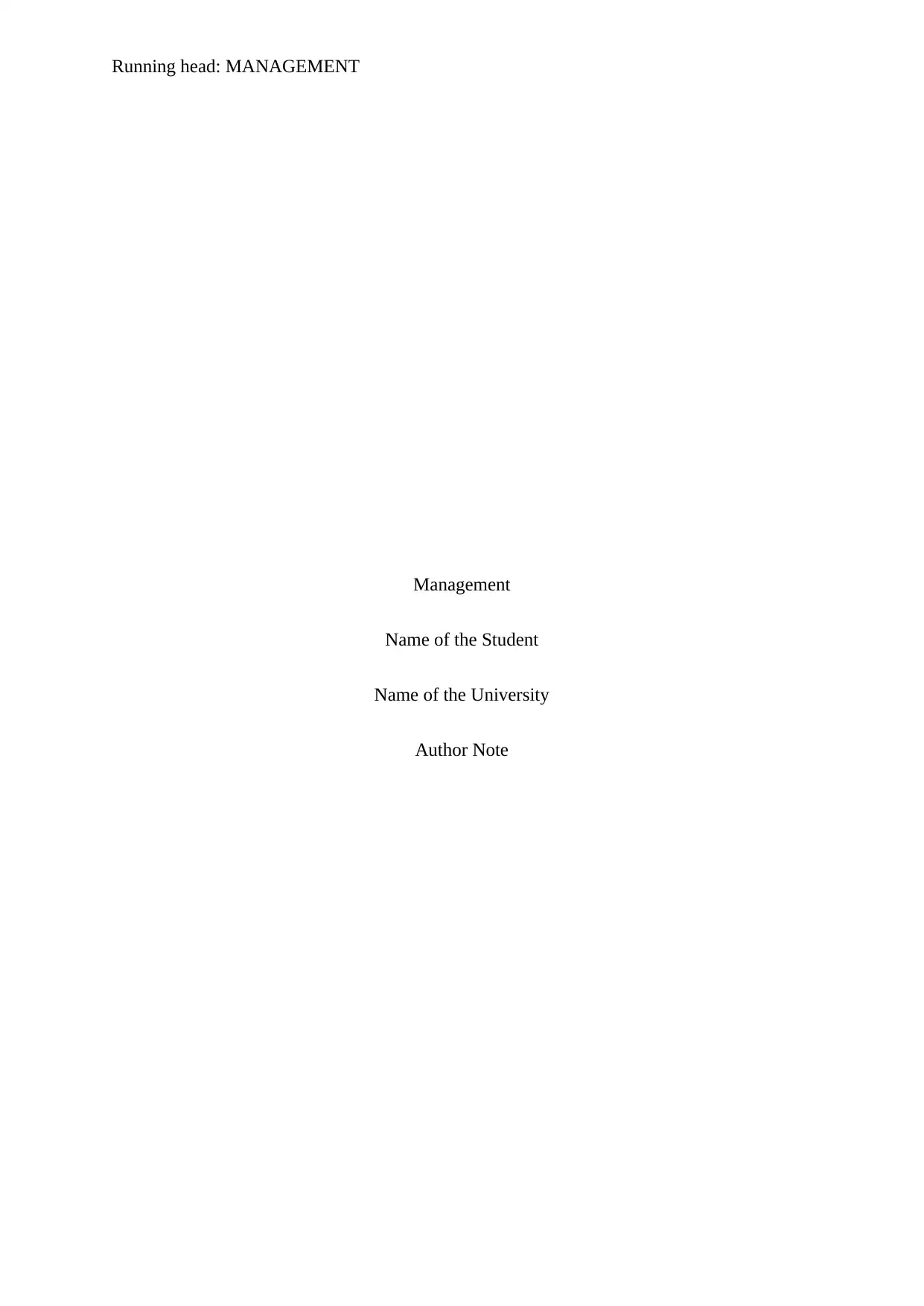
Running head: MANAGEMENT
Management
Name of the Student
Name of the University
Author Note
Management
Name of the Student
Name of the University
Author Note
Secure Best Marks with AI Grader
Need help grading? Try our AI Grader for instant feedback on your assignments.
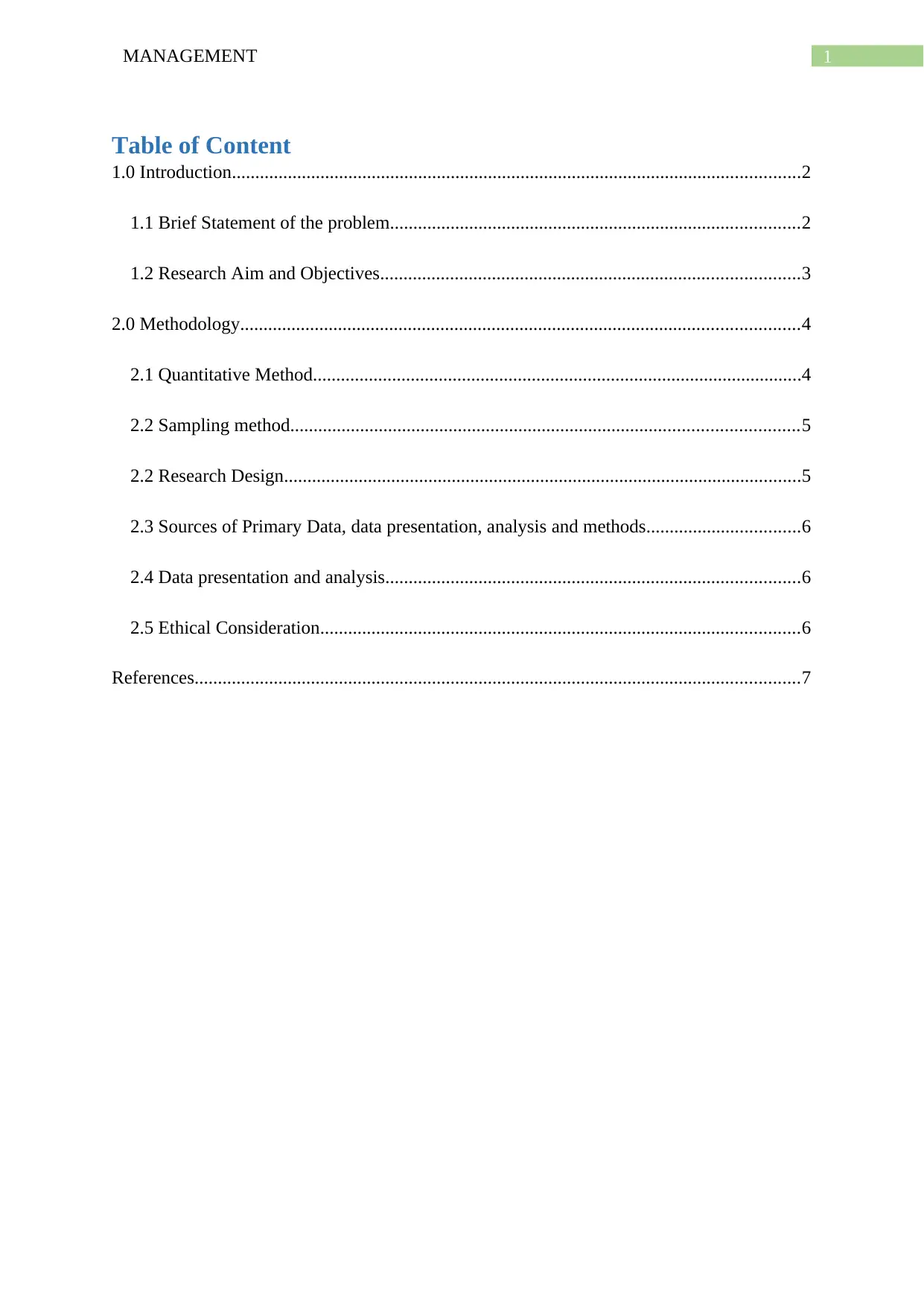
1MANAGEMENT
Table of Content
1.0 Introduction..........................................................................................................................2
1.1 Brief Statement of the problem........................................................................................2
1.2 Research Aim and Objectives..........................................................................................3
2.0 Methodology........................................................................................................................4
2.1 Quantitative Method.........................................................................................................4
2.2 Sampling method.............................................................................................................5
2.2 Research Design...............................................................................................................5
2.3 Sources of Primary Data, data presentation, analysis and methods.................................6
2.4 Data presentation and analysis.........................................................................................6
2.5 Ethical Consideration.......................................................................................................6
References..................................................................................................................................7
Table of Content
1.0 Introduction..........................................................................................................................2
1.1 Brief Statement of the problem........................................................................................2
1.2 Research Aim and Objectives..........................................................................................3
2.0 Methodology........................................................................................................................4
2.1 Quantitative Method.........................................................................................................4
2.2 Sampling method.............................................................................................................5
2.2 Research Design...............................................................................................................5
2.3 Sources of Primary Data, data presentation, analysis and methods.................................6
2.4 Data presentation and analysis.........................................................................................6
2.5 Ethical Consideration.......................................................................................................6
References..................................................................................................................................7
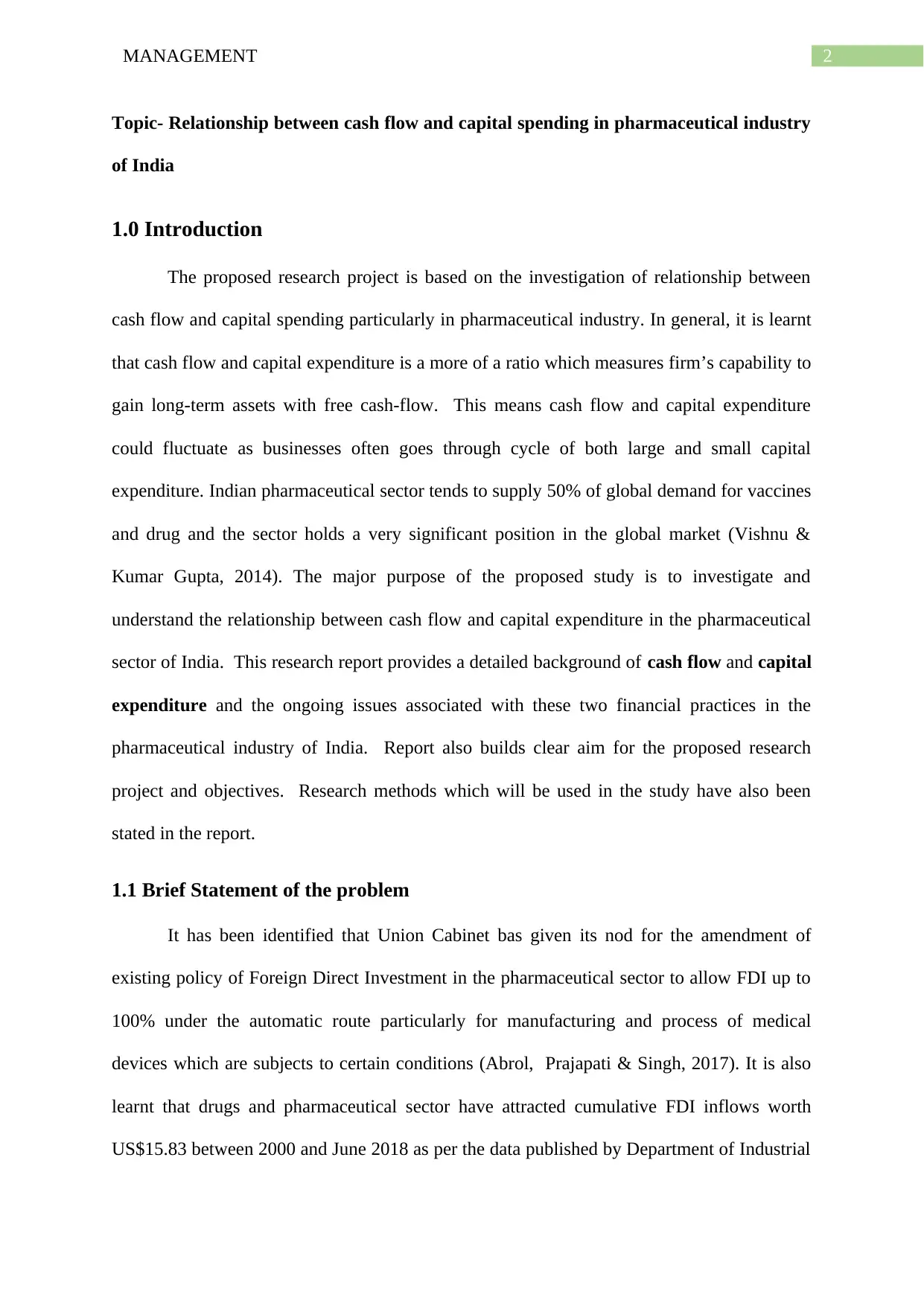
2MANAGEMENT
Topic- Relationship between cash flow and capital spending in pharmaceutical industry
of India
1.0 Introduction
The proposed research project is based on the investigation of relationship between
cash flow and capital spending particularly in pharmaceutical industry. In general, it is learnt
that cash flow and capital expenditure is a more of a ratio which measures firm’s capability to
gain long-term assets with free cash-flow. This means cash flow and capital expenditure
could fluctuate as businesses often goes through cycle of both large and small capital
expenditure. Indian pharmaceutical sector tends to supply 50% of global demand for vaccines
and drug and the sector holds a very significant position in the global market (Vishnu &
Kumar Gupta, 2014). The major purpose of the proposed study is to investigate and
understand the relationship between cash flow and capital expenditure in the pharmaceutical
sector of India. This research report provides a detailed background of cash flow and capital
expenditure and the ongoing issues associated with these two financial practices in the
pharmaceutical industry of India. Report also builds clear aim for the proposed research
project and objectives. Research methods which will be used in the study have also been
stated in the report.
1.1 Brief Statement of the problem
It has been identified that Union Cabinet bas given its nod for the amendment of
existing policy of Foreign Direct Investment in the pharmaceutical sector to allow FDI up to
100% under the automatic route particularly for manufacturing and process of medical
devices which are subjects to certain conditions (Abrol, Prajapati & Singh, 2017). It is also
learnt that drugs and pharmaceutical sector have attracted cumulative FDI inflows worth
US$15.83 between 2000 and June 2018 as per the data published by Department of Industrial
Topic- Relationship between cash flow and capital spending in pharmaceutical industry
of India
1.0 Introduction
The proposed research project is based on the investigation of relationship between
cash flow and capital spending particularly in pharmaceutical industry. In general, it is learnt
that cash flow and capital expenditure is a more of a ratio which measures firm’s capability to
gain long-term assets with free cash-flow. This means cash flow and capital expenditure
could fluctuate as businesses often goes through cycle of both large and small capital
expenditure. Indian pharmaceutical sector tends to supply 50% of global demand for vaccines
and drug and the sector holds a very significant position in the global market (Vishnu &
Kumar Gupta, 2014). The major purpose of the proposed study is to investigate and
understand the relationship between cash flow and capital expenditure in the pharmaceutical
sector of India. This research report provides a detailed background of cash flow and capital
expenditure and the ongoing issues associated with these two financial practices in the
pharmaceutical industry of India. Report also builds clear aim for the proposed research
project and objectives. Research methods which will be used in the study have also been
stated in the report.
1.1 Brief Statement of the problem
It has been identified that Union Cabinet bas given its nod for the amendment of
existing policy of Foreign Direct Investment in the pharmaceutical sector to allow FDI up to
100% under the automatic route particularly for manufacturing and process of medical
devices which are subjects to certain conditions (Abrol, Prajapati & Singh, 2017). It is also
learnt that drugs and pharmaceutical sector have attracted cumulative FDI inflows worth
US$15.83 between 2000 and June 2018 as per the data published by Department of Industrial
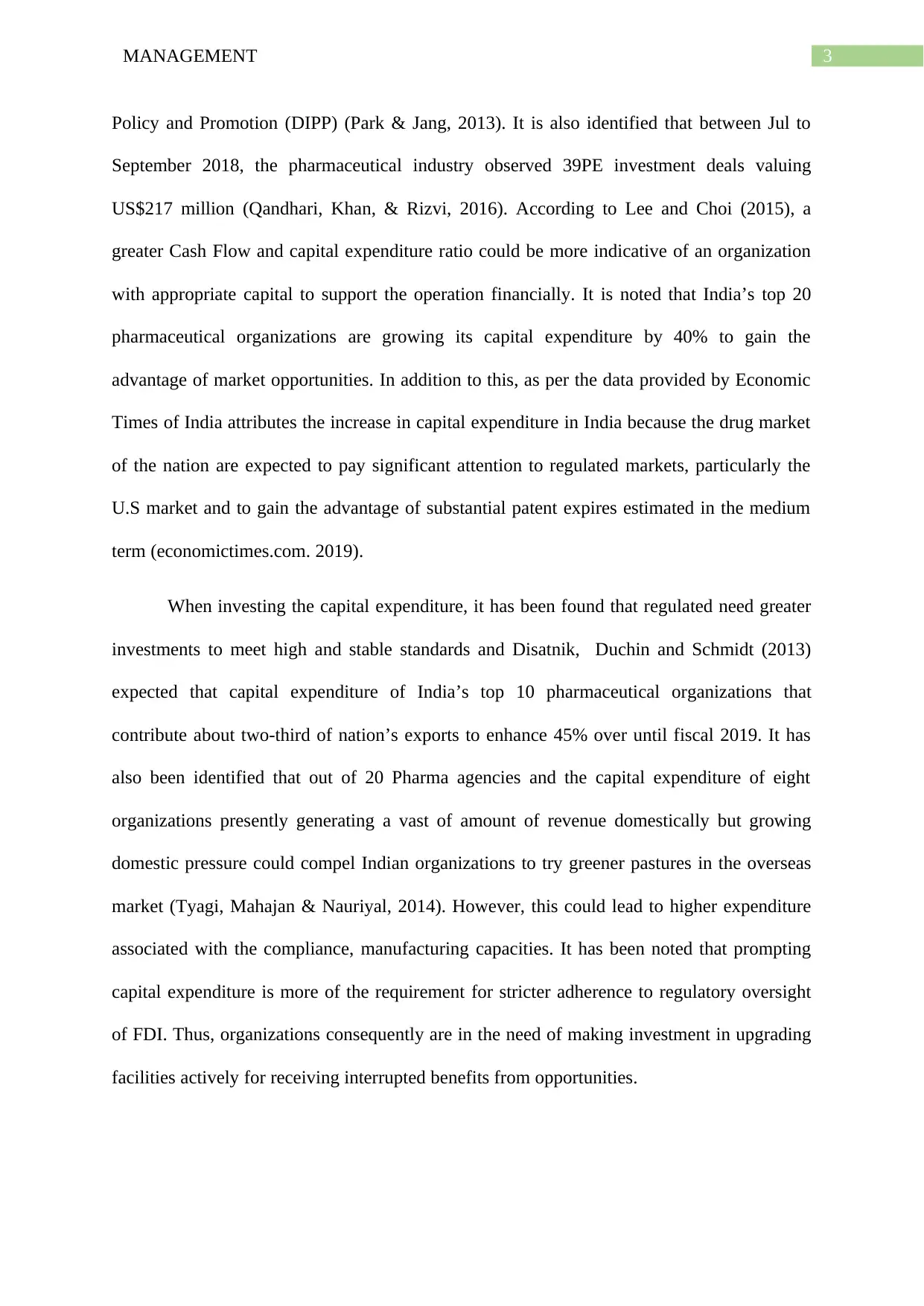
3MANAGEMENT
Policy and Promotion (DIPP) (Park & Jang, 2013). It is also identified that between Jul to
September 2018, the pharmaceutical industry observed 39PE investment deals valuing
US$217 million (Qandhari, Khan, & Rizvi, 2016). According to Lee and Choi (2015), a
greater Cash Flow and capital expenditure ratio could be more indicative of an organization
with appropriate capital to support the operation financially. It is noted that India’s top 20
pharmaceutical organizations are growing its capital expenditure by 40% to gain the
advantage of market opportunities. In addition to this, as per the data provided by Economic
Times of India attributes the increase in capital expenditure in India because the drug market
of the nation are expected to pay significant attention to regulated markets, particularly the
U.S market and to gain the advantage of substantial patent expires estimated in the medium
term (economictimes.com. 2019).
When investing the capital expenditure, it has been found that regulated need greater
investments to meet high and stable standards and Disatnik, Duchin and Schmidt (2013)
expected that capital expenditure of India’s top 10 pharmaceutical organizations that
contribute about two-third of nation’s exports to enhance 45% over until fiscal 2019. It has
also been identified that out of 20 Pharma agencies and the capital expenditure of eight
organizations presently generating a vast of amount of revenue domestically but growing
domestic pressure could compel Indian organizations to try greener pastures in the overseas
market (Tyagi, Mahajan & Nauriyal, 2014). However, this could lead to higher expenditure
associated with the compliance, manufacturing capacities. It has been noted that prompting
capital expenditure is more of the requirement for stricter adherence to regulatory oversight
of FDI. Thus, organizations consequently are in the need of making investment in upgrading
facilities actively for receiving interrupted benefits from opportunities.
Policy and Promotion (DIPP) (Park & Jang, 2013). It is also identified that between Jul to
September 2018, the pharmaceutical industry observed 39PE investment deals valuing
US$217 million (Qandhari, Khan, & Rizvi, 2016). According to Lee and Choi (2015), a
greater Cash Flow and capital expenditure ratio could be more indicative of an organization
with appropriate capital to support the operation financially. It is noted that India’s top 20
pharmaceutical organizations are growing its capital expenditure by 40% to gain the
advantage of market opportunities. In addition to this, as per the data provided by Economic
Times of India attributes the increase in capital expenditure in India because the drug market
of the nation are expected to pay significant attention to regulated markets, particularly the
U.S market and to gain the advantage of substantial patent expires estimated in the medium
term (economictimes.com. 2019).
When investing the capital expenditure, it has been found that regulated need greater
investments to meet high and stable standards and Disatnik, Duchin and Schmidt (2013)
expected that capital expenditure of India’s top 10 pharmaceutical organizations that
contribute about two-third of nation’s exports to enhance 45% over until fiscal 2019. It has
also been identified that out of 20 Pharma agencies and the capital expenditure of eight
organizations presently generating a vast of amount of revenue domestically but growing
domestic pressure could compel Indian organizations to try greener pastures in the overseas
market (Tyagi, Mahajan & Nauriyal, 2014). However, this could lead to higher expenditure
associated with the compliance, manufacturing capacities. It has been noted that prompting
capital expenditure is more of the requirement for stricter adherence to regulatory oversight
of FDI. Thus, organizations consequently are in the need of making investment in upgrading
facilities actively for receiving interrupted benefits from opportunities.
Secure Best Marks with AI Grader
Need help grading? Try our AI Grader for instant feedback on your assignments.
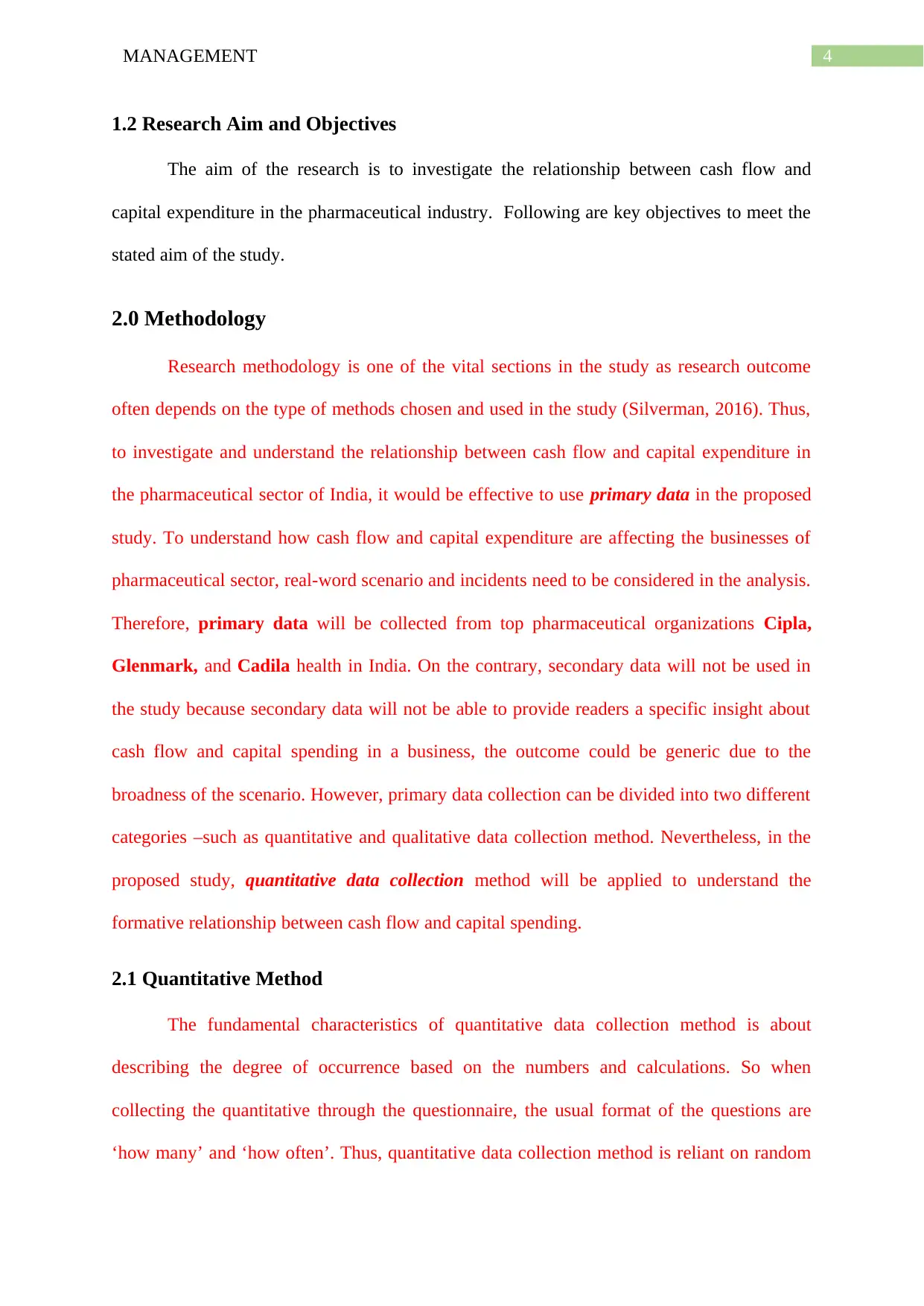
4MANAGEMENT
1.2 Research Aim and Objectives
The aim of the research is to investigate the relationship between cash flow and
capital expenditure in the pharmaceutical industry. Following are key objectives to meet the
stated aim of the study.
2.0 Methodology
Research methodology is one of the vital sections in the study as research outcome
often depends on the type of methods chosen and used in the study (Silverman, 2016). Thus,
to investigate and understand the relationship between cash flow and capital expenditure in
the pharmaceutical sector of India, it would be effective to use primary data in the proposed
study. To understand how cash flow and capital expenditure are affecting the businesses of
pharmaceutical sector, real-word scenario and incidents need to be considered in the analysis.
Therefore, primary data will be collected from top pharmaceutical organizations Cipla,
Glenmark, and Cadila health in India. On the contrary, secondary data will not be used in
the study because secondary data will not be able to provide readers a specific insight about
cash flow and capital spending in a business, the outcome could be generic due to the
broadness of the scenario. However, primary data collection can be divided into two different
categories –such as quantitative and qualitative data collection method. Nevertheless, in the
proposed study, quantitative data collection method will be applied to understand the
formative relationship between cash flow and capital spending.
2.1 Quantitative Method
The fundamental characteristics of quantitative data collection method is about
describing the degree of occurrence based on the numbers and calculations. So when
collecting the quantitative through the questionnaire, the usual format of the questions are
‘how many’ and ‘how often’. Thus, quantitative data collection method is reliant on random
1.2 Research Aim and Objectives
The aim of the research is to investigate the relationship between cash flow and
capital expenditure in the pharmaceutical industry. Following are key objectives to meet the
stated aim of the study.
2.0 Methodology
Research methodology is one of the vital sections in the study as research outcome
often depends on the type of methods chosen and used in the study (Silverman, 2016). Thus,
to investigate and understand the relationship between cash flow and capital expenditure in
the pharmaceutical sector of India, it would be effective to use primary data in the proposed
study. To understand how cash flow and capital expenditure are affecting the businesses of
pharmaceutical sector, real-word scenario and incidents need to be considered in the analysis.
Therefore, primary data will be collected from top pharmaceutical organizations Cipla,
Glenmark, and Cadila health in India. On the contrary, secondary data will not be used in
the study because secondary data will not be able to provide readers a specific insight about
cash flow and capital spending in a business, the outcome could be generic due to the
broadness of the scenario. However, primary data collection can be divided into two different
categories –such as quantitative and qualitative data collection method. Nevertheless, in the
proposed study, quantitative data collection method will be applied to understand the
formative relationship between cash flow and capital spending.
2.1 Quantitative Method
The fundamental characteristics of quantitative data collection method is about
describing the degree of occurrence based on the numbers and calculations. So when
collecting the quantitative through the questionnaire, the usual format of the questions are
‘how many’ and ‘how often’. Thus, quantitative data collection method is reliant on random
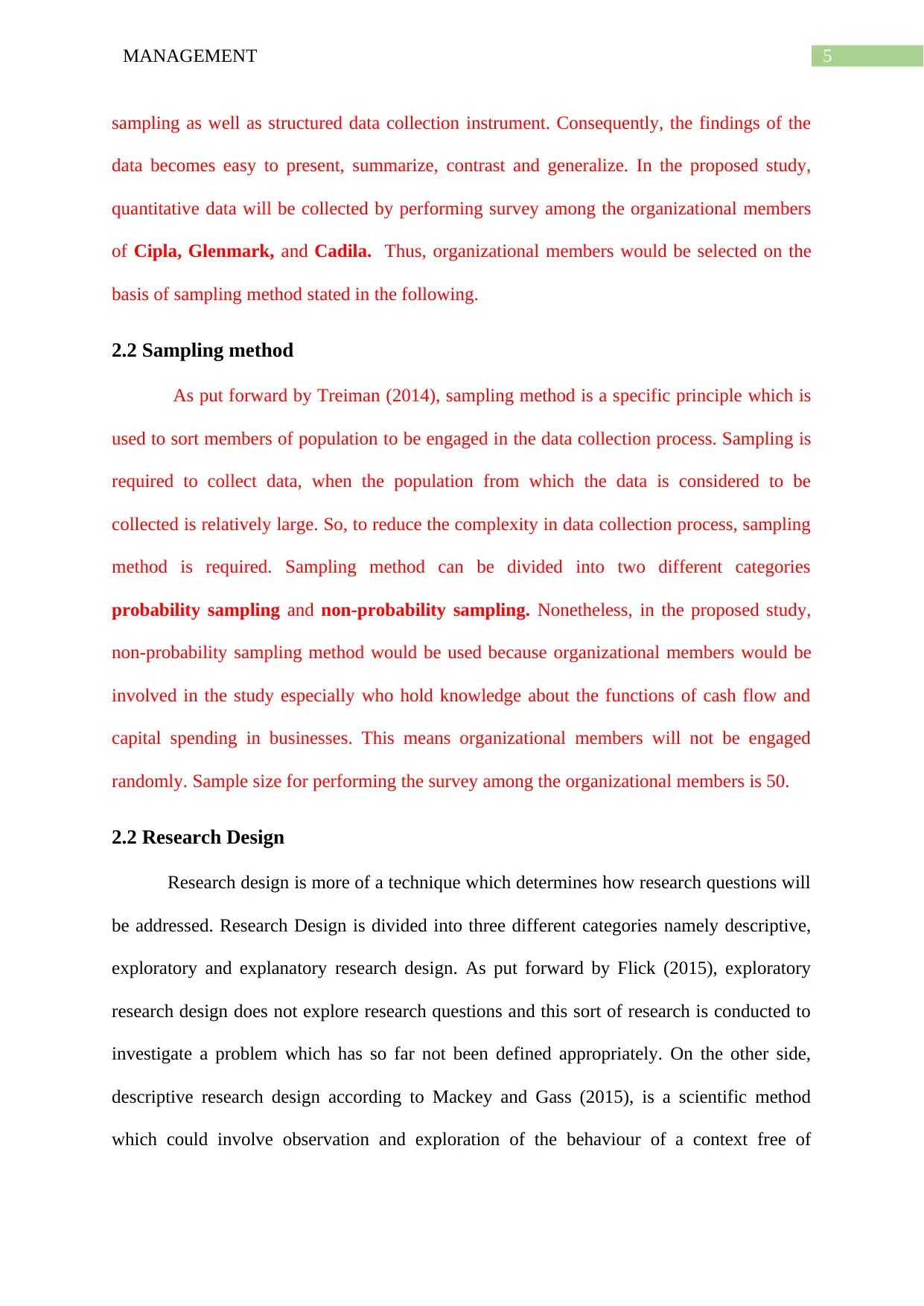
5MANAGEMENT
sampling as well as structured data collection instrument. Consequently, the findings of the
data becomes easy to present, summarize, contrast and generalize. In the proposed study,
quantitative data will be collected by performing survey among the organizational members
of Cipla, Glenmark, and Cadila. Thus, organizational members would be selected on the
basis of sampling method stated in the following.
2.2 Sampling method
As put forward by Treiman (2014), sampling method is a specific principle which is
used to sort members of population to be engaged in the data collection process. Sampling is
required to collect data, when the population from which the data is considered to be
collected is relatively large. So, to reduce the complexity in data collection process, sampling
method is required. Sampling method can be divided into two different categories
probability sampling and non-probability sampling. Nonetheless, in the proposed study,
non-probability sampling method would be used because organizational members would be
involved in the study especially who hold knowledge about the functions of cash flow and
capital spending in businesses. This means organizational members will not be engaged
randomly. Sample size for performing the survey among the organizational members is 50.
2.2 Research Design
Research design is more of a technique which determines how research questions will
be addressed. Research Design is divided into three different categories namely descriptive,
exploratory and explanatory research design. As put forward by Flick (2015), exploratory
research design does not explore research questions and this sort of research is conducted to
investigate a problem which has so far not been defined appropriately. On the other side,
descriptive research design according to Mackey and Gass (2015), is a scientific method
which could involve observation and exploration of the behaviour of a context free of
sampling as well as structured data collection instrument. Consequently, the findings of the
data becomes easy to present, summarize, contrast and generalize. In the proposed study,
quantitative data will be collected by performing survey among the organizational members
of Cipla, Glenmark, and Cadila. Thus, organizational members would be selected on the
basis of sampling method stated in the following.
2.2 Sampling method
As put forward by Treiman (2014), sampling method is a specific principle which is
used to sort members of population to be engaged in the data collection process. Sampling is
required to collect data, when the population from which the data is considered to be
collected is relatively large. So, to reduce the complexity in data collection process, sampling
method is required. Sampling method can be divided into two different categories
probability sampling and non-probability sampling. Nonetheless, in the proposed study,
non-probability sampling method would be used because organizational members would be
involved in the study especially who hold knowledge about the functions of cash flow and
capital spending in businesses. This means organizational members will not be engaged
randomly. Sample size for performing the survey among the organizational members is 50.
2.2 Research Design
Research design is more of a technique which determines how research questions will
be addressed. Research Design is divided into three different categories namely descriptive,
exploratory and explanatory research design. As put forward by Flick (2015), exploratory
research design does not explore research questions and this sort of research is conducted to
investigate a problem which has so far not been defined appropriately. On the other side,
descriptive research design according to Mackey and Gass (2015), is a scientific method
which could involve observation and exploration of the behaviour of a context free of
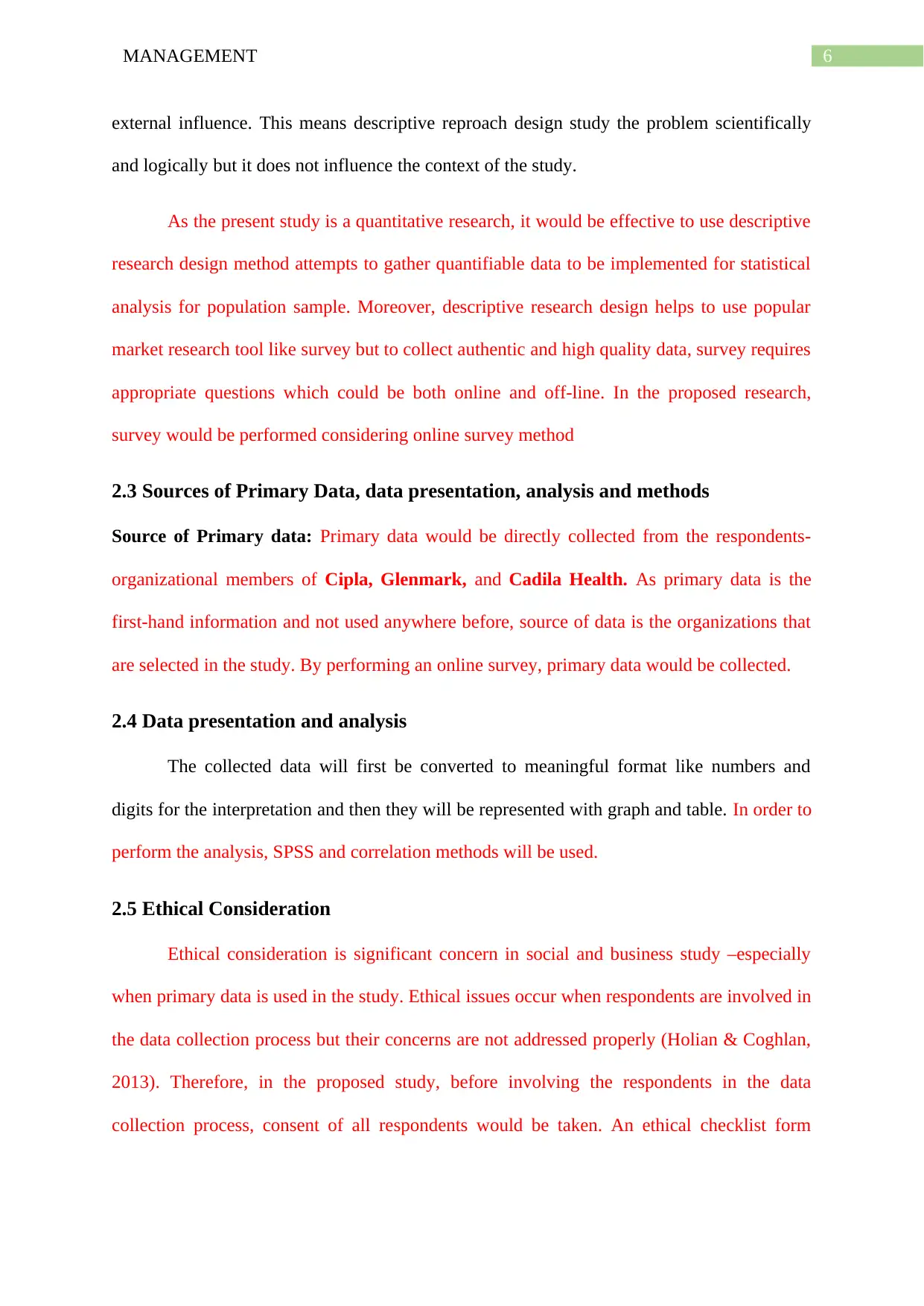
6MANAGEMENT
external influence. This means descriptive reproach design study the problem scientifically
and logically but it does not influence the context of the study.
As the present study is a quantitative research, it would be effective to use descriptive
research design method attempts to gather quantifiable data to be implemented for statistical
analysis for population sample. Moreover, descriptive research design helps to use popular
market research tool like survey but to collect authentic and high quality data, survey requires
appropriate questions which could be both online and off-line. In the proposed research,
survey would be performed considering online survey method
2.3 Sources of Primary Data, data presentation, analysis and methods
Source of Primary data: Primary data would be directly collected from the respondents-
organizational members of Cipla, Glenmark, and Cadila Health. As primary data is the
first-hand information and not used anywhere before, source of data is the organizations that
are selected in the study. By performing an online survey, primary data would be collected.
2.4 Data presentation and analysis
The collected data will first be converted to meaningful format like numbers and
digits for the interpretation and then they will be represented with graph and table. In order to
perform the analysis, SPSS and correlation methods will be used.
2.5 Ethical Consideration
Ethical consideration is significant concern in social and business study –especially
when primary data is used in the study. Ethical issues occur when respondents are involved in
the data collection process but their concerns are not addressed properly (Holian & Coghlan,
2013). Therefore, in the proposed study, before involving the respondents in the data
collection process, consent of all respondents would be taken. An ethical checklist form
external influence. This means descriptive reproach design study the problem scientifically
and logically but it does not influence the context of the study.
As the present study is a quantitative research, it would be effective to use descriptive
research design method attempts to gather quantifiable data to be implemented for statistical
analysis for population sample. Moreover, descriptive research design helps to use popular
market research tool like survey but to collect authentic and high quality data, survey requires
appropriate questions which could be both online and off-line. In the proposed research,
survey would be performed considering online survey method
2.3 Sources of Primary Data, data presentation, analysis and methods
Source of Primary data: Primary data would be directly collected from the respondents-
organizational members of Cipla, Glenmark, and Cadila Health. As primary data is the
first-hand information and not used anywhere before, source of data is the organizations that
are selected in the study. By performing an online survey, primary data would be collected.
2.4 Data presentation and analysis
The collected data will first be converted to meaningful format like numbers and
digits for the interpretation and then they will be represented with graph and table. In order to
perform the analysis, SPSS and correlation methods will be used.
2.5 Ethical Consideration
Ethical consideration is significant concern in social and business study –especially
when primary data is used in the study. Ethical issues occur when respondents are involved in
the data collection process but their concerns are not addressed properly (Holian & Coghlan,
2013). Therefore, in the proposed study, before involving the respondents in the data
collection process, consent of all respondents would be taken. An ethical checklist form
Paraphrase This Document
Need a fresh take? Get an instant paraphrase of this document with our AI Paraphraser
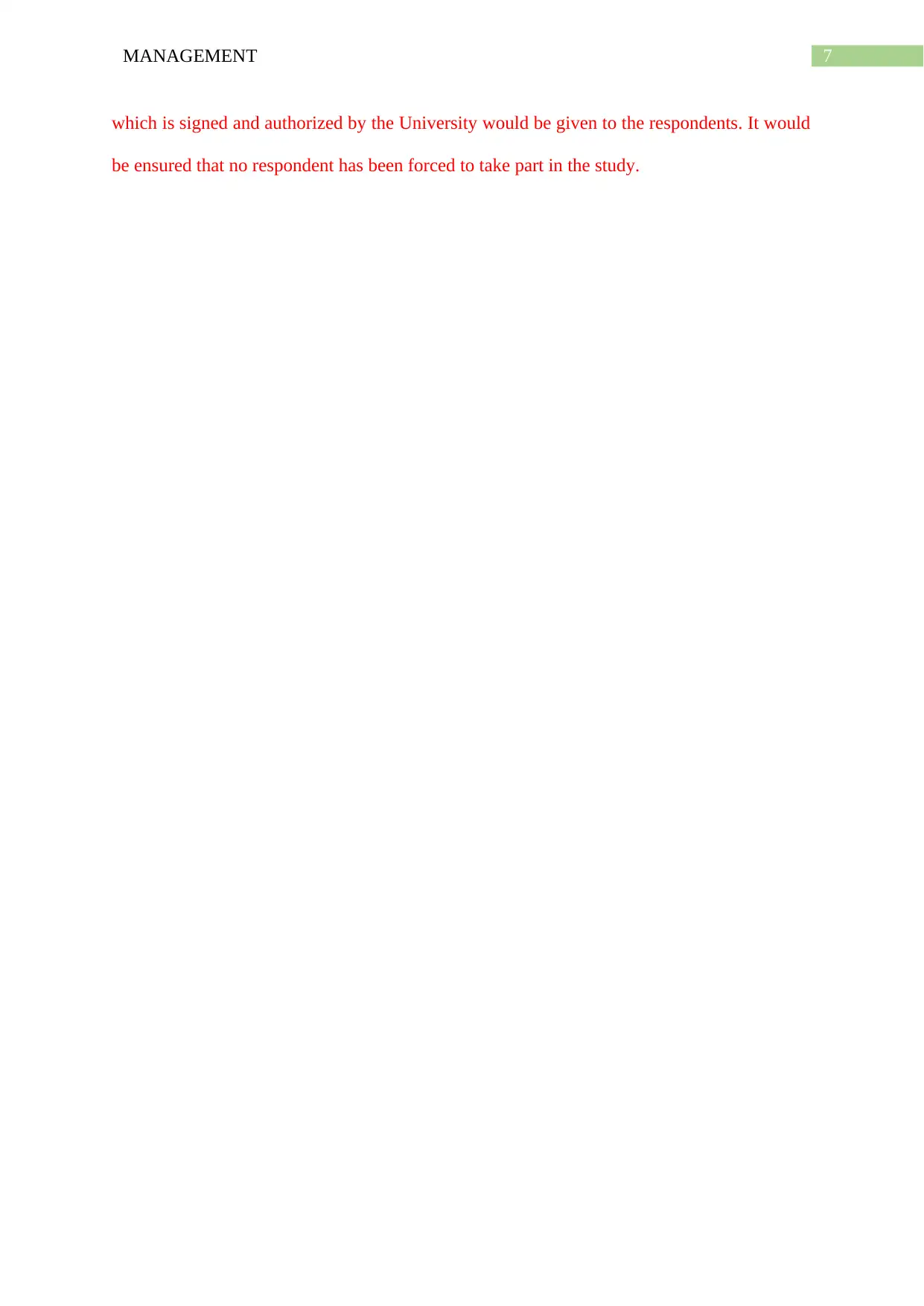
7MANAGEMENT
which is signed and authorized by the University would be given to the respondents. It would
be ensured that no respondent has been forced to take part in the study.
which is signed and authorized by the University would be given to the respondents. It would
be ensured that no respondent has been forced to take part in the study.
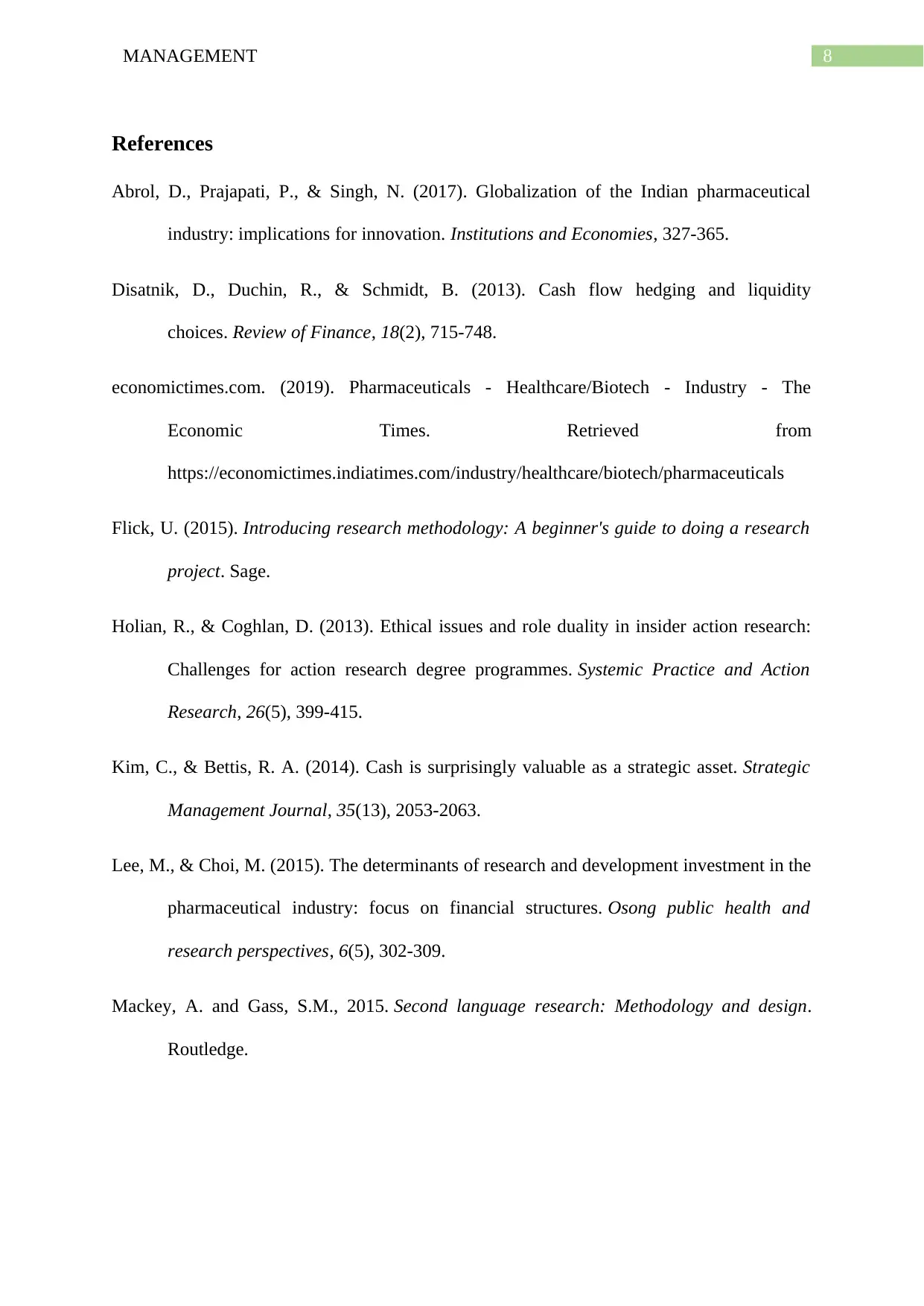
8MANAGEMENT
References
Abrol, D., Prajapati, P., & Singh, N. (2017). Globalization of the Indian pharmaceutical
industry: implications for innovation. Institutions and Economies, 327-365.
Disatnik, D., Duchin, R., & Schmidt, B. (2013). Cash flow hedging and liquidity
choices. Review of Finance, 18(2), 715-748.
economictimes.com. (2019). Pharmaceuticals - Healthcare/Biotech - Industry - The
Economic Times. Retrieved from
https://economictimes.indiatimes.com/industry/healthcare/biotech/pharmaceuticals
Flick, U. (2015). Introducing research methodology: A beginner's guide to doing a research
project. Sage.
Holian, R., & Coghlan, D. (2013). Ethical issues and role duality in insider action research:
Challenges for action research degree programmes. Systemic Practice and Action
Research, 26(5), 399-415.
Kim, C., & Bettis, R. A. (2014). Cash is surprisingly valuable as a strategic asset. Strategic
Management Journal, 35(13), 2053-2063.
Lee, M., & Choi, M. (2015). The determinants of research and development investment in the
pharmaceutical industry: focus on financial structures. Osong public health and
research perspectives, 6(5), 302-309.
Mackey, A. and Gass, S.M., 2015. Second language research: Methodology and design.
Routledge.
References
Abrol, D., Prajapati, P., & Singh, N. (2017). Globalization of the Indian pharmaceutical
industry: implications for innovation. Institutions and Economies, 327-365.
Disatnik, D., Duchin, R., & Schmidt, B. (2013). Cash flow hedging and liquidity
choices. Review of Finance, 18(2), 715-748.
economictimes.com. (2019). Pharmaceuticals - Healthcare/Biotech - Industry - The
Economic Times. Retrieved from
https://economictimes.indiatimes.com/industry/healthcare/biotech/pharmaceuticals
Flick, U. (2015). Introducing research methodology: A beginner's guide to doing a research
project. Sage.
Holian, R., & Coghlan, D. (2013). Ethical issues and role duality in insider action research:
Challenges for action research degree programmes. Systemic Practice and Action
Research, 26(5), 399-415.
Kim, C., & Bettis, R. A. (2014). Cash is surprisingly valuable as a strategic asset. Strategic
Management Journal, 35(13), 2053-2063.
Lee, M., & Choi, M. (2015). The determinants of research and development investment in the
pharmaceutical industry: focus on financial structures. Osong public health and
research perspectives, 6(5), 302-309.
Mackey, A. and Gass, S.M., 2015. Second language research: Methodology and design.
Routledge.
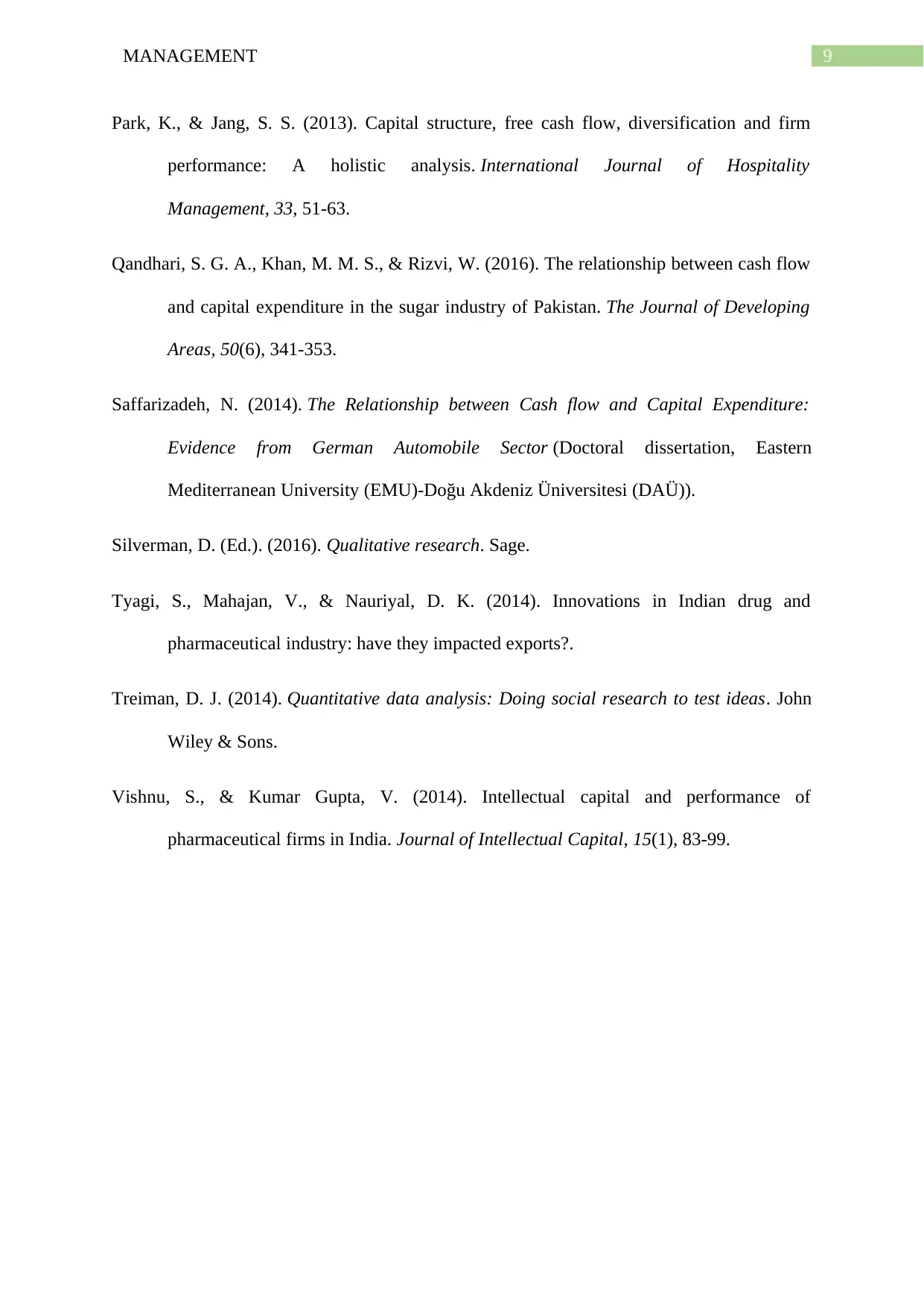
9MANAGEMENT
Park, K., & Jang, S. S. (2013). Capital structure, free cash flow, diversification and firm
performance: A holistic analysis. International Journal of Hospitality
Management, 33, 51-63.
Qandhari, S. G. A., Khan, M. M. S., & Rizvi, W. (2016). The relationship between cash flow
and capital expenditure in the sugar industry of Pakistan. The Journal of Developing
Areas, 50(6), 341-353.
Saffarizadeh, N. (2014). The Relationship between Cash flow and Capital Expenditure:
Evidence from German Automobile Sector (Doctoral dissertation, Eastern
Mediterranean University (EMU)-Doğu Akdeniz Üniversitesi (DAÜ)).
Silverman, D. (Ed.). (2016). Qualitative research. Sage.
Tyagi, S., Mahajan, V., & Nauriyal, D. K. (2014). Innovations in Indian drug and
pharmaceutical industry: have they impacted exports?.
Treiman, D. J. (2014). Quantitative data analysis: Doing social research to test ideas. John
Wiley & Sons.
Vishnu, S., & Kumar Gupta, V. (2014). Intellectual capital and performance of
pharmaceutical firms in India. Journal of Intellectual Capital, 15(1), 83-99.
Park, K., & Jang, S. S. (2013). Capital structure, free cash flow, diversification and firm
performance: A holistic analysis. International Journal of Hospitality
Management, 33, 51-63.
Qandhari, S. G. A., Khan, M. M. S., & Rizvi, W. (2016). The relationship between cash flow
and capital expenditure in the sugar industry of Pakistan. The Journal of Developing
Areas, 50(6), 341-353.
Saffarizadeh, N. (2014). The Relationship between Cash flow and Capital Expenditure:
Evidence from German Automobile Sector (Doctoral dissertation, Eastern
Mediterranean University (EMU)-Doğu Akdeniz Üniversitesi (DAÜ)).
Silverman, D. (Ed.). (2016). Qualitative research. Sage.
Tyagi, S., Mahajan, V., & Nauriyal, D. K. (2014). Innovations in Indian drug and
pharmaceutical industry: have they impacted exports?.
Treiman, D. J. (2014). Quantitative data analysis: Doing social research to test ideas. John
Wiley & Sons.
Vishnu, S., & Kumar Gupta, V. (2014). Intellectual capital and performance of
pharmaceutical firms in India. Journal of Intellectual Capital, 15(1), 83-99.
1 out of 10
Related Documents
Your All-in-One AI-Powered Toolkit for Academic Success.
+13062052269
info@desklib.com
Available 24*7 on WhatsApp / Email
![[object Object]](/_next/static/media/star-bottom.7253800d.svg)
Unlock your academic potential
© 2024 | Zucol Services PVT LTD | All rights reserved.





